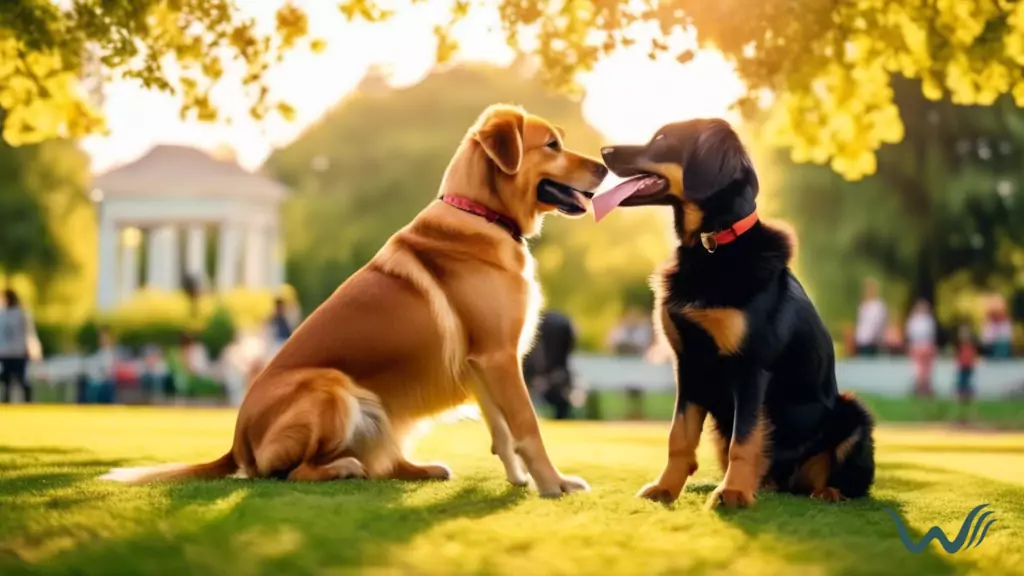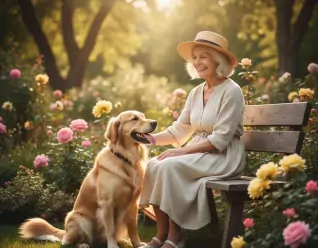

Socializing Your Dog With Service Pets
by Tayyaba Amir
Last updated: April 18, 2024
Verified and Approved by:
Angela Morris,
MSW, LCSW
Fact Checked

Imagine your dog as a lone sailor navigating the vast sea of social interactions. Now picture a service pet as a guiding light, leading your furry friend towards safe harbors of companionship and understanding. Socializing your dog with service pets can be a rewarding journey that not only strengthens their social skills but also fosters a sense of empathy and connection with others.
As you embark on this adventure, you will discover the many benefits of exposing your dog to different types of service animals. From emotional support dogs to therapy horses, each interaction opens up a new world of learning and growth for your beloved companion. By following proper etiquette and training techniques, you can ensure that these encounters are not only enjoyable but also safe for all parties involved.
Key Takeaways
- Service pets act as guiding lights for dogs in social interactions
- Socializing dogs with service pets strengthens social skills, fosters empathy, and boosts confidence while reducing anxiety
- Exposing dogs to different types of service animals is important for their social development
- Proper etiquette, consistency, and patience are key in training dogs to interact safely with service pets
Understanding Service Pets
If you’ve ever wondered how service pets are trained to assist their owners, you’ll be amazed at the intelligence and dedication these animals possess. Service pets undergo rigorous training to learn specific tasks that help individuals with disabilities lead more independent lives. Whether it’s guiding the visually impaired, alerting someone with hearing loss, or providing emotional support, these animals are truly remarkable in their ability to understand and fulfill their roles.
Service pets are not just highly skilled, they are also incredibly intuitive and compassionate. They are trained to anticipate their owner’s needs and provide assistance before even being asked. Their loyalty and dedication to helping others go above and beyond what is expected, making them invaluable companions for those in need. By understanding the important role that service pets play in the lives of their owners, you can better appreciate the impact they have on improving the quality of life for individuals with disabilities.
Benefits of Socializing Your Dog
By introducing your furry friend to other trained animals, you can help them become more comfortable and confident in new environments. Socializing your dog with service pets offers numerous benefits that can positively impact their overall well-being and behavior.
Here are three emotional reasons why socializing your dog is beneficial:
- Increased Confidence: Interacting with service pets can boost your dog’s self-confidence, making them more secure in unfamiliar situations.
- Reduced Anxiety: Socializing your dog with other animals can help alleviate anxiety and fear, leading to a happier and more relaxed pup.
- Enhanced Social Skills: By engaging with service pets, your dog can improve their communication and socialization skills, making them more adaptable and friendly in various settings.
Remember, by socializing your dog with service pets, you’re not only benefiting your furry companion but also contributing to their development as a well-rounded and emotionally intelligent animal.
Proper Etiquette for Dog Interactions
When meeting other animals, it’s important to be respectful and mindful of their boundaries and signals. Just like humans, animals have their own ways of communicating and interacting with each other. When introducing your dog to a service pet, it’s essential to observe their body language and behavior to ensure a positive interaction. Always ask the owner for permission before approaching their service animal, as they may be working and need to focus on their task at hand.
To help you navigate proper etiquette when interacting with service pets, here is a simple guide to follow:
| Do’s | Don’ts |
|---|---|
| Ask for permission before petting the service animal | Approach the service animal without permission |
| Allow the service pet space to work without distractions | Make loud noises or sudden movements around the service animal |
| Respect the service animal’s personal space | Feed the service animal without the owner’s approval |
| Follow any instructions given by the service pet’s owner | Assume the service animal is available for play or interaction at all times |
| Be patient and understanding if the service animal needs to focus on their job | Allow your dog to bark or lunge at the service animal |
By following these simple guidelines, you can ensure a positive and respectful interaction between your dog and service pets, ultimately contributing to a harmonious socialization experience for all involved.
Training Techniques for Socialization
To train effectively, you should start early and continue reinforcing positive behaviors consistently. Did you know that 65% of service dogs are trained using positive reinforcement techniques? This method focuses on rewarding good behavior rather than punishing mistakes, creating a strong bond between you and your dog.
Here are some key training techniques to help socialize your dog with service pets:
- Consistency: Make sure to consistently reinforce positive behaviors to help your dog understand what is expected of them.
- Socialization: Expose your dog to different environments, people, and animals to help them become more comfortable and confident in various situations.
- Patience: Remember that training takes time and patience, so stay calm and positive throughout the process to support your dog’s learning journey.
By using these training techniques, you can help your dog become well-socialized and ready to interact with service pets positively and respectfully. Your dedication to training will not only benefit your dog but also contribute to creating a harmonious environment for all animals involved in service work.
Safety Measures for Successful Introductions
Ensure that safety measures are in place for successful introductions of your furry friend to other animals. When introducing your dog to a service pet, it is important to prioritize safety for both animals involved. Always keep your dog on a leash and under control during the initial meeting. Additionally, consider using a barrier or gate to create a safe distance between the two animals, allowing them to sniff and observe each other without direct contact. Monitoring their body language and behavior closely can help prevent any potential conflicts and ensure a smooth introduction process.
| Safety Measure | Description |
|---|---|
| Leash Control | Keep your dog on a leash to maintain control and prevent any sudden movements. |
| Barrier Usage | Use a barrier or gate to create a safe distance between your dog and the service pet during the first meeting. |
| Body Language Observation | Monitor the body language of both animals to ensure they are comfortable and relaxed during the introduction. |
| Supervision | Always supervise the interaction between your dog and the service pet to intervene if needed and ensure a safe environment for both. |
Frequently Asked Questions
Can service pets be trained to interact with different types of animals, such as birds or rabbits?
Yes, service pets can be trained to interact with different types of animals like birds or rabbits. By using positive reinforcement techniques and gradual exposure, they can learn to calmly coexist and even assist with their care.
Are there specific guidelines for socializing a dog with a service cat or other non-traditional service animal?
Wondering how to socialize your dog with a service cat or other non-traditional service animal? Remember, patience and positive reinforcement are key. Start with gradual introductions in a controlled environment to build trust and respect.
How can I ensure my dog is not overly excited or disruptive when interacting with a service pet in public settings?
To ensure your dog isn’t overly excited or disruptive around service pets in public, focus on positive reinforcement, calm energy, and gradual exposure. Encourage gentle interactions and respect the service animal’s space and purpose.
Are there any considerations for socializing a dog with a service pet that has special medical or behavioral needs?
When socializing a dog with a service pet having special needs, be mindful of their unique requirements. Approach gently, respect boundaries, and stay calm to create a positive interaction. Understanding and empathy go a long way.
What should I do if my dog shows signs of fear or aggression towards a service pet during socialization attempts?
If your dog shows fear or aggression towards a service pet, calmly remove them from the situation to prevent any harm. Seek guidance from a professional trainer to address the behavior and ensure positive interactions.
Certify Your Emotional Support Animal Today

Why You Can Rely on Us?
At Wellness Wag, we believe your pet deserves care rooted in both science and compassion. Each article is carefully researched, written in clear language for pet owners, and then reviewed by qualified professionals to ensure the information is evidence-based, current, and practical for real-life care. Our goal is to help you feel confident in making informed decisions about your pet’s health and well-being.
Reviewed by
Angela Morris, MSW, LCSW
Angela is a licensed clinical social worker with 20 years of experience in patient advocacy and community mental health. She has assisted numerous clients with ESA evaluations and brings a deep understanding of disability accommodations, ensuring that all information is accurate, supportive, and practical.

Written by :
Tayyaba Amir
Last Updated :
April 18, 2024










